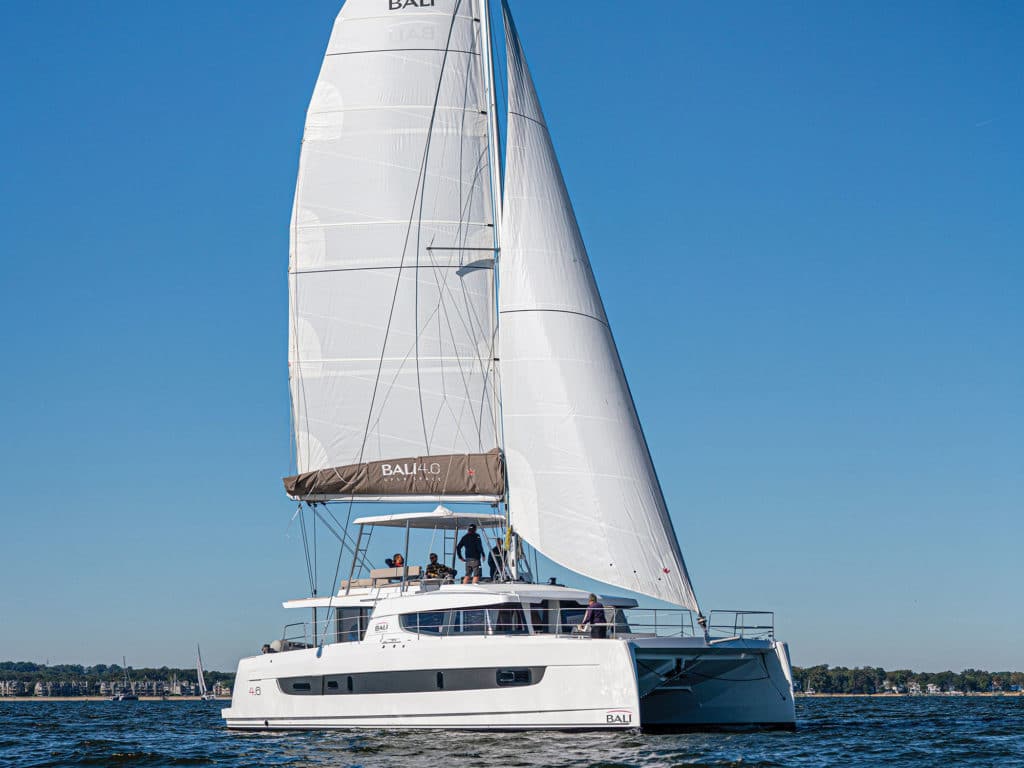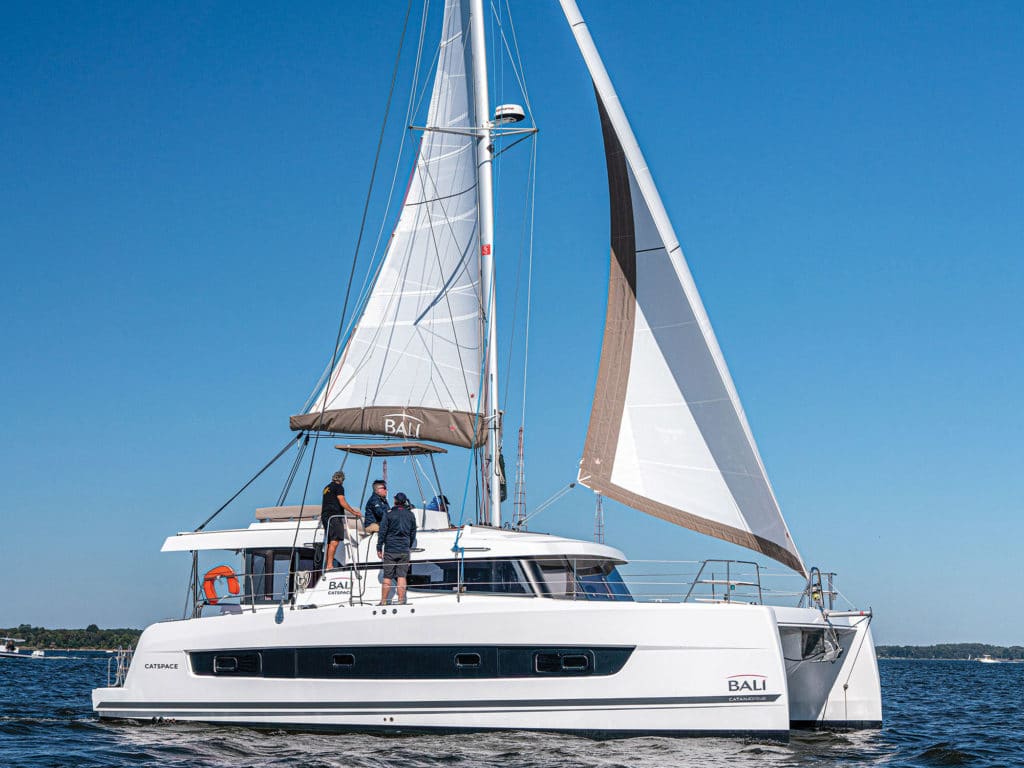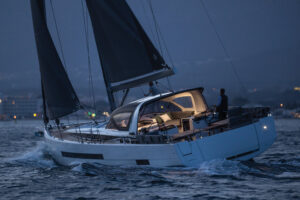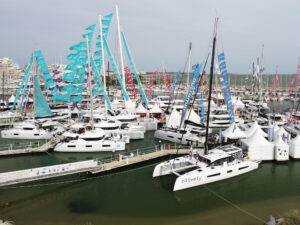
When Cruising World’s Boat of the Year judges step aboard a new sailboat, the first thing they ask the builder for is the boat’s design brief. Racing? Bluewater voyaging? Coastal cruising? Chartering? Daysailing? What’s the boat built to do?
In the case of two new Bali Catamarans, introduced to North America this past fall during the United States Sailboat Show in Annapolis, Maryland, the manufacturer’s intent seemed perfectly clear: These cats were built for hanging out on the water with family and friends, or perhaps for owners interested in putting them into a charter fleet to help pay the bills. “Pampered crew” were two words that came immediately to mind when I stepped aboard.
Both cats—the Bali 4.6 and Bali Catspace—were conceived of by Olivier Poncin, founder of the Catana Group, and designed by the in-house team that has been building well-respected performance catamarans at their yard in France for nearly four decades now.
When I think about Catana Catamarans, features such as daggerboards, sleek hulls and powerful sail plans designed to gobble up ocean miles come immediately to mind. When I think about Bali, my mind turns to comfortable surroundings and tropical anchorages, with soothing trade winds blowing through the saloon and multiple places to lounge in the sun or shade.
The Catana Group launched the Bali brand in 2014, on the company’s 30th anniversary. At the time, the multihull market was exploding, and while Catana had a strong following at the performance end of the speed-comfort continuum, their boats were expensive and geared to a niche market. Balis, on the other hand, were designed and built to be “more accessible in terms of price,” the company’s online brochure notes, and “therefore aimed at a wider clientele.” It’s no accident that many of those clients chose to add their Balis to charter fleets in the Caribbean and other tropical spots around the world. As a result, the brand took off, to the point where today, it takes up the bulk of Catana’s production capacity.
The 4.6 and Catspace share many of the same features found across the Bali Range: solid composite foredecks rather than the trampolines found on most catamarans; multiple spaces to kick back and relax; home-style refrigerators in the galleys; large sliding windows on the cabin sides; and garage-style doors that open and lift overhead aft in the saloon, making it difficult to discern where the interior stops and the great outdoors begins.
The sail-away prices of the boats we visited in Annapolis were $920,000 for the 4.6 and $550,000 for the Catspace. In all, Bali manufactures seven sailing models and two power cats, so buyers have options when it comes to size and price.
Bali hulls and decks are resin-infused and foam-cored, which makes them strong and stiff while saving weight. Throughout the range, Balis are built with short, fixed keels, affixed to relatively beamy hulls that have abundant load-carrying capacity. In practice, that means the boats can be loaded with gear such as air conditioning, appliances and generators—and toys and provisions for all the crew.
With a length overall of 44 feet, 6 inches, the 4.6 presents a number of interesting features and options. First, there is the flybridge, set atop the cockpit Bimini and a portion of cabin top abaft the mast. It can be reached via steps on either side deck. A helm station is to port, with a bench that seats two comfortably. Adjacent to it is a good-size table with L-shaped seating around it, and sun beds behind. The wheel itself is mounted on a pedestal, and there’s room to walk in front, between it and the winches mounted on the cabin top. With this arrangement, there’s room for the crew to jump in and help trim sails, though without helpers, it does require the skipper to rely on the autopilot when leaving the helm to tend to sheets.
Underway, I liked the setup. There was good visibility, both around the boat and also of the mainsail overhead, thanks to a window in the canvas Bimini. The main was simple to control using the double-ended sheet led to blocks on the corners of the flybridge, replacing the traveler. The arrangement is especially good for jibing.
In a good breeze, 10 to 12 knots, our speed over the ground hovered right around 5 knots; we added a knot to that when we bore off to a beam reach. If I bought the boat and didn’t have plans to put it into charter, I’d definitely add a code zero to my sail arsenal.
Down below, I liked the layout of the saloon as well. With the sliding windows and overhead door open, I had the feeling of being outside, sitting in the shade. The dining table is to port; two chairs are opposite. Forward of the table is an L-shaped galley to port with loads of counter space; a large fridge and freezer sits opposite, with a proper nav station tucked forward, surrounded by windows and adjacent to the centerline door leading to another lounge area on the foredeck.
Depending on how the boat will be used, there are a few different layouts for the staterooms and heads, ranging from a three-stateroom version, where the entire starboard hull is the owner’s en suite, to four- and even five-stateroom layouts. In the latter, access to the port aft stateroom is by a companionway from the cockpit, and a stateroom with bunk beds is amidships, with a third stateroom forward. Crew berths in either forepeak are also available.
The 4.6 we tested in Annapolis was powered by a pair of 57 hp Yanmars with saildrives; 45 hp Yanmars are standard.

At just over 37 feet length overall, the Catspace is one of the smaller production cats available these days. It also has an airy feeling in the saloon’s dining and lounging area, thanks to a similar aft door arrangement. But space doesn’t permit a second door to the foredeck. Instead, there’s a larger center window that opens to let in the breeze, and the galley (including a full-size fridge) is in the forward starboard corner of the main cabin.
Available layouts include a three-stateroom version, where the owner’s stateroom occupies the port hull, or a charter-friendly four-stateroom layout, with athwartship bunks in the two forward staterooms.
As with its bigger sister, the Catspace has lounge areas on the foredeck and atop its flybridge. The helm station is up top too, to starboard, and is surrounded on the side and behind with cushions. Unlike the 4.6, the Catspace’s winches are close at hand when sitting at the wheel. A singlehander or skipper with a short-handed crew will appreciate this. I found access to the flybridge via stairs from either side deck to be quite good, with handholds located where I needed them.
Again, if I planned to buy and sail the Catspace, I’d include a code zero or some other all-round reaching sail to add a little more get-up-and-go. We went sailing in about 15 knots of wind and notched about 4 knots on the speedo closehauled. In a higher puff, I saw just under 6 knots reaching. But was it a comfortable ride? You bet.
As stated at the outset, sailboats are built to suit a purpose. During a Boat of the Year debrief this past fall, judge Tim Murphy told his colleagues that overall, he thought that the open-air concept incorporated into the design of the 4.6 and Catspace works quite well. Recalling a weeklong vacation spent with five friends aboard an earlier Bali model, he said, “On the charter, it was actually delightful.”
Specifications
| Bali 4.6 | |
|---|---|
| LOA | 46’11” |
| LWL | 43’10” |
| Beam | 25’2″ |
| Draft | 4’2″ |
| Displ. | 30,429 lb. |
| Sail Area | 1,722 sq. ft. |
| D/L | 161 |
| SA/D | 28.3 |
| Price | $920,000 |
| Bali Catspace | |
| LOA | 40’5″ |
| LWL | 37’3″ |
| Beam | 21’6″ |
| Draft | 3’11” |
| Displ. | 20,727 lb. |
| Sail Area | 1,087 sq. ft. |
| D/L | 179 |
| SA/D | 23.0 |
| Price | $550,000 |
Mark Pillsbury is a CW editor-at-large.








